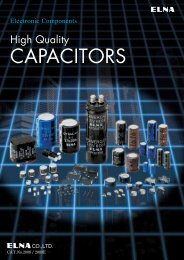Aluminum Electrolytic Capacitors
Aluminum Electrolytic Capacitors
Aluminum Electrolytic Capacitors
You also want an ePaper? Increase the reach of your titles
YUMPU automatically turns print PDFs into web optimized ePapers that Google loves.
ALUMINUM ELECTROLYTIC CAPACITORS®the dropped capacitor.• Do not deform the capacitor for mounting.2. Do not apply excessive pressure to the capacitor,its terminals or lead wires.• Make sure that the contact path of the capacitormeets the hole pitch of the PCB before mounting.• Transient recovery voltage may be generated in thecapacitor due to dielectric absorption. If required,this voltage can be discharged with a resistor witha value of about 1 k.• A PCB self-standing (snap-in) type capacitor shouldbe pushed to the end (till there is no space) to thePCB for mounting.• Do not set the automatic insertion machine to clinchthe capacitor lead wires too strong.• Pay attention to the impact given by the componentreceptacles of the automatic insertion/mountingmachines and the product checker, and fromthe centering operation.3. Soldering.• Do not dip the capacitor into melted solder.• The soldering conditionsChip type : Please refer to 11 page.small and large type : 260°C, 10 s (max.)The preliminary heating and other conditionsdescribed in the catalog or product specifications.• Do not flux other part than the terminals.• If there is a direct contact between the sleeve ofthe capacitor and the printed circuit pattern or ametal part of another component such as a leadwire, it may cause shrinkage of crack.• When you use the capacitor with its sleeve touchingdirectly to the PCB, excessive solder temperatureor excessive soldering time may cause thesleeve to shrink or crack during the heat.• If the application is for extended use, understandand manage the soldering characteristics to avoidabnormal current caused by a contact failurebetween the capacitor and the PCB.4. Handling after soldering.• After soldering, do not tilt, push down or twist thecapacitor.• After soldering, do not hold the capacitor as ahandle to carry the PCB.• After soldering, do not hit the capacitor with anyobstacle. If PCB’s are piled up for storage, thecapacitor should not touch another PCB or component.5. Cleaning after Soldering• Recommended cleaning method(1)cleaning solutions:(a) CLEANTHROUGH 710M, 750H, 750L(b) PINEALPHA ST-100S(c) Techno Care FRW-4~17(d) Isopropyl alcohol (2-propanol)CAT.No.2010/2011E(2)Cleaning conditions:(a) The temperature of cleaning solution shall beless than 60°C.(b) Use immersion or ultrasonic waves within twominutes.(c) After cleaning, capacitors and PCB’s shallthoroughly be rinsed and dried with hot blastfor more than 10 minutes. The temperature ofsuch breeze should be less than the uppercategory temperature.(d) After cleaning, do not keep capacitors incleaning solution atmosphere or airtightcontainers.• During cleaning, control the cleaning solutionagainst contamination.6. Fixing adhesives and coating materials.• Do not use fixing adhesive or coating materialcontaining halogen-based solvent.• Before applying the fixing adhesive or the coatingmaterial, make sure that there is no remaining fluxor stains between the PCB and the sealed part ofthe capacitor.• Before applying the fixing adhesive or the coatingmaterial, make sure that the detergent etc. hasdried up.• Do not cover the whole surface of the sealed part(terminal side) of the capacitor with the fixing adhesiveor the coating material.• Observe the description in the catalog or the productspecifications concerning the thermal stiffeningconditions of the fixing adhesive or the coatingmaterial. (If there is no such description, contactus.) When both discrete and SMT components areon the same PCB, the fixing material for the SMTcomponents may cause crack, tear or shrinkage onthe external sleeve depending on the thermalstiffening condition.• Recommended fixing adhesives and coatingmaterialsFixing adhesives : Cemedine 210, 501, 540, 545N, DiabondDN83K, DA3288, Bond G103Coating materials : Taffy TF1159, HumiSeal 1B66, 1A27NSOther Cautions1. Do not touch capacitor terminals with bare hands.You may get electric shock or your hand may beburnt. Discharge it with a 1 K resistance before useif necessary.2. Do not short the capacitor terminals with a conductor.Do not spill conductive solution including acid or alkalinesolution on the capacitor.3. Periodical inspections should be establishedfor the capacitors used in industrial appliances.• The following items should be checked:






